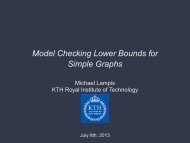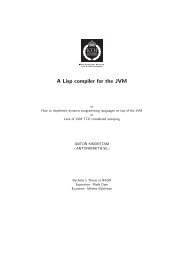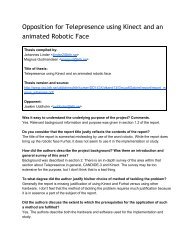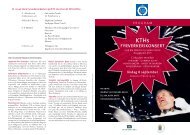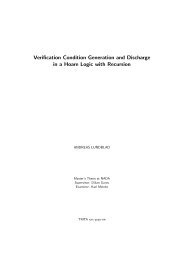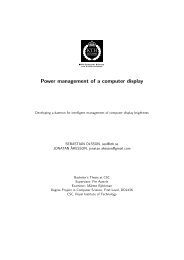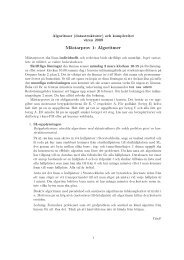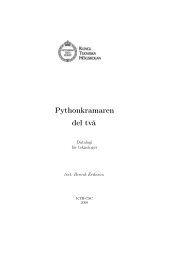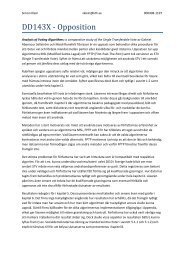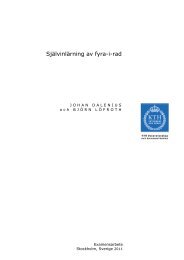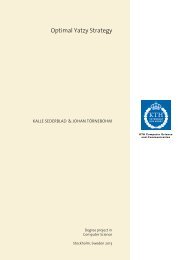Evaluation of Automatic Text Summarization - KTH
Evaluation of Automatic Text Summarization - KTH
Evaluation of Automatic Text Summarization - KTH
You also want an ePaper? Increase the reach of your titles
YUMPU automatically turns print PDFs into web optimized ePapers that Google loves.
12 CHAPTER 1. SUMMARIES AND THE PROCESS OF SUMMARIZATION<br />
1.3.2.4 Keyword Association<br />
Keyword association is an inexpensive, but somewhat shallower, approach that<br />
relies on keywords associated (either manually or automatically) to the documents<br />
being summarized. For example Saggion and Lapalme (2000) presented human<br />
judges with summaries generated by their summarization system together with<br />
five lists <strong>of</strong> keywords taken from the source article as presented in the publication<br />
journal. The judges were then given the task to associate the each summary with<br />
the correct list <strong>of</strong> keywords. If successful the summary was said to cover the central<br />
aspects <strong>of</strong> the article since the keywords associated to the article by the publisher<br />
were content indicative. Its main advantage is that it requires no cumbersome<br />
manual annotation.<br />
1.3.3 <strong>Evaluation</strong> Tools<br />
In order to allow a more rigorous and repeatable evaluation procedure, partly by<br />
automating the comparison <strong>of</strong> summaries, it is advantageous to build an extract<br />
corpus containing originals and their extracts, i.e. summaries strictly made by<br />
extraction <strong>of</strong> whole sentences from an original text. Each extract, whether made<br />
by a human informant or a machine, is meant to be a true summary <strong>of</strong> the original,<br />
i.e. to retain the meaning <strong>of</strong> the text as good as possible. Since the sentence units <strong>of</strong><br />
the original text and the various summaries are known entities, the construction and<br />
analysis <strong>of</strong> an extract corpus can almost completely be left to computer programs, if<br />
these are well-designed. A number <strong>of</strong> tools have been developed for these purposes.<br />
1.3.3.1 Summary <strong>Evaluation</strong> Environment<br />
Summary <strong>Evaluation</strong> Environment (SEE; Lin 2001) is an evaluation environment<br />
in which assessors can evaluate the quality <strong>of</strong> a summary, called the peer text, in<br />
comparison to a reference summary, called the model text. The texts involved in<br />
the evaluation are pre-processed by being broken up into a list <strong>of</strong> segments (phrases,<br />
sentences, clauses, etc.) depending on the granularity <strong>of</strong> the evaluation. For example,<br />
when evaluating an extraction based summarization system that works on the<br />
sentence level, the texts are pre-processed by being broken up into sentences.<br />
During the evaluation phase, the two summaries are shown in two separate<br />
panels in SEE and interfaces are provided for assessors to judge both the content and<br />
the quality <strong>of</strong> summaries. To measure content, the assessor proceeds through the<br />
summary being evaluated, unit by unit, and clicks on one or more associated units<br />
in the model summary. For each click, the assessor can specify whether the marked<br />
units express all, most, some or hardly any <strong>of</strong> the content <strong>of</strong> the clicked model<br />
unit. To measure quality, assessors rate grammaticality, cohesion, and coherence<br />
at five different levels: all, most, some, hardly any, or none. Quality is assessed<br />
both for each unit <strong>of</strong> the peer summary and for overall quality <strong>of</strong> the peer summary<br />
(coherence, length, content coverage, grammaticality, and organization <strong>of</strong> the peer



